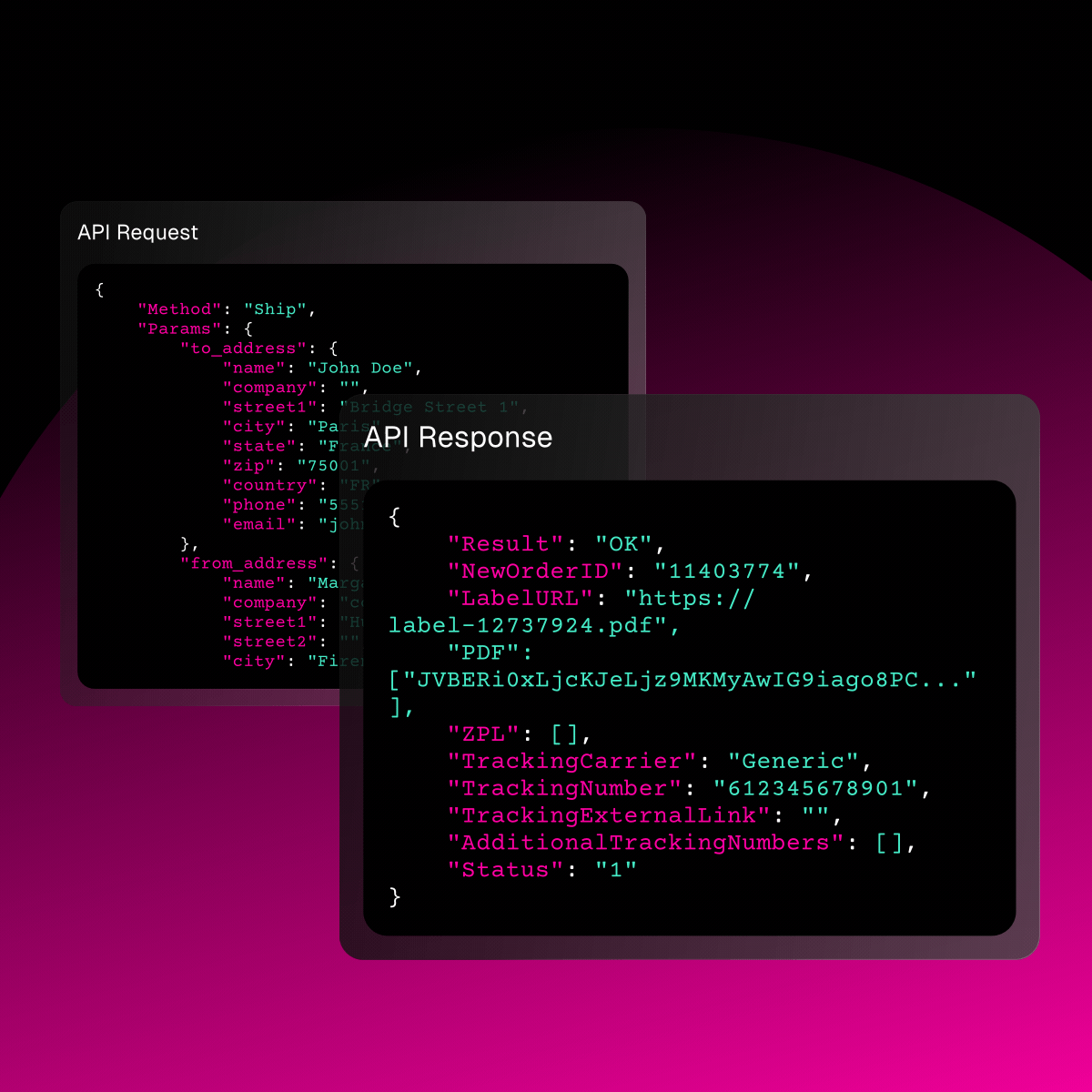Shipping Automation: how to streamline logistics management
 By
Giulia Castagna
·
7 minute read
By
Giulia Castagna
·
7 minute read
Companies start with small shipping volumes. In today's world, they grow at a rapid pace going from dozens to thousands of shipments in a couple of years or less. To keep up with an increasing number of tasks, automation is needed.
In this article, we will show you how shipping automation can help you in reaching a competitive advantage and what it can be used for.
Shipping automation applies to processes such as freight audit, updated tracking, smart picking, and inventory management. With customised rules, systems optimise carrier selection, cost monitoring, and customer notifications. Automation frees human resources from repetitive tasks, ensures operational efficiency, and allows for adaptation to seasonal peaks such as Black Friday. It is a strategic lever for improving competitiveness and end-to-end logistics..
Back to the basics: what is shipping automation?
Shipping automation refers to setting automatic rules to manage and speed up the shipping flow from inventory management to parcel auditing, label generation, and order fulfilment.
It encompasses the use of software solutions and hardware technologies to optimise and streamline shipping operations. This allows businesses to handle their shipping needs more efficiently, with little to no human intervention and increased accuracy.
For example, if you need to ship all orders weighing less than 15 kg with UPS, you can create a specific automatic rule with which the carrier handles all of the orders with this characteristic. Each rule on destination area, weight and package size is applicable.
The goal of shipping automation is to eliminate repetitive tasks, increase operational efficiency, and help companies scale their logistics easily.
10 uses of shipping automation
Shipping automation is like spices, you can use them everywhere to improve your performance. So here are 10 uses of shipping automation that can simplify your business tasks.
- Automated shipping label generation
- Parcel audit
- Update tracking information
- Data standardisation
- Carrier selection
- Address validation
- Documents generation and management
- Smart picking
- Inventory management
- Streamlined customer service
1. Shipping label automation
Shipping label generation can be automated no matter where you ship from, to, or with whom. By implementing automated label generation, businesses can streamline their fulfilment processes, leading to quicker dispatch times and improved customer satisfaction.
Generating shipping labels can help businesses scale order fulfilment processes, especially during peak season and Black Friday.
Additionally, automatic label generation can help you standardise label formats no matter the carriers you're shipping with.
Calculate time saved with automation
Enter the number of labels to generate. Average manual time: 60s / label. With automation: 1s / label.
Manual time
Automation time
Time saved
Reduction
—
2. Parcel audit

Parcel audit plays a key role in ensuring shipping cost accuracy and identifying discrepancies in carrier billing. Businesses can detect overcharges, incorrect service levels, and billing errors by automatically cross-referencing shipment invoices with the original order data.
Regular audits can identify issues like recurring overcharges by specific carriers, discrepancies or common errors. These insights enable businesses to renegotiate contracts or adjust their shipping strategies.
The automation of this process ensures that audits are conducted consistently and accurately, freeing up human resources for more strategic tasks and reducing human errors that could arise from manual auditing.
3. Update tracking information
Keep your customers informed at all times with the power of shipping automation. You can set up rules to send tracking information from the carrier to your end customers in just a few clicks.
You can choose whether to inform your customers at every stage of the delivery journey or just in key moments like order fulfilment, out for delivery, and parcel delivered. You can even choose the communication channels to use like SMS, emails or WhatsApp notifications.
4. Data standardisation
One of the biggest challenges when dealing with a multiplayer ecosystem is data standardisation.
By standardising data formats, businesses can ensure seamless communication between different systems, such as order management, warehouse management, and carrier platforms.
This harmonisation reduces the risk of errors caused by incompatible data and facilitates smoother transaction processing. Moreover, standardised data enables better analysis and reporting, providing clearer insights into shipping performance and operational bottlenecks.
5. Carrier selection
Choosing the best carrier for each order can become a time-consuming task, especially when the shipping volume increases to hundreds of parcels per day.
Automating the carrier selection is a good way to scale the process, and save money. It's possible to set up shipping rules based on parcel weight, dimensions, and destination country. In this way, you'll be able to manage your shipments in bulk and choose the most convenient carrier for every order.
Additionally, by leveraging data on shipping volumes and preferences, companies can identify the most frequently used carriers and negotiate bulk discounts or improved service terms. This strategic approach reduces shipping costs and ensures a higher level of service reliability.
6. Address validation
A wrongly formatted address may cost companies money and negatively impact their customer experience.
Automated address validation ensures that shipping addresses are correct and complete before dispatch, significantly reducing the risk of delivery failures and returns. By integrating with global address databases, automated systems can verify and correct addresses in real time, flagging potential issues before they impact delivery.
7. Documents generation and management
Ten years ago, paper and digital documents co-existed. Today, the world's bureaucracy is becoming paperless. In this instance, shipping automation has become a must-have tool to ensure document compliance and timely dispatches.
Systems can automatically produce invoices, packing lists, customs declarations, and other necessary documents, ensuring they are accurate and compliant with relevant regulations.
In addition to generation, automated document management systems organise and store documents efficiently, making them easily accessible for future reference or audits. This improves record-keeping and compliance, as all required documents are systematically archived and can be retrieved quickly when needed.
8. Smart picking
Smart picking uses robotics, artificial intelligence, and machine learning to optimise the warehouse picking process.
Automated systems can analyse order data and warehouse layouts to determine the most efficient picking routes, significantly reducing the time and effort required to fulfil orders. Smart picking also enhances accuracy by using barcode scanners, RFID tags, and vision systems to ensure the correct items are selected and packed.
9. Inventory management
Automated inventory management systems provide real-time visibility into stock levels, enabling businesses to avoid stockouts or overstock situations.
These systems use advanced algorithms to forecast demand, track inventory movements, and manage reordering processes, ensuring that stock levels are aligned with customer demand and business needs. Automation also reduces the risk of human error in inventory tracking, providing more accurate and reliable data.
Additionally, automated inventory management systems can integrate with other business systems such as ERP and order management platforms, creating a cohesive ecosystem that enhances overall supply chain efficiency.
10. Streamlined customer service
When everything goes wrong, and your customers face unexpected issues, it's time to automate customer service.
The idea is not to use machines instead of human resources to manage your requests but to introduce automation rules that support your team and help them in their daily tasks.
For example, you could automate the introductory questions to describe the customer's problem and send articles from your help centre rather than letting an employee do that manually every time.
Moreover, automated systems can integrate with customer service platforms to provide representatives with instant access to shipping information, enabling them to respond to customer inquiries more efficiently. This reduces the time customers spend waiting for answers and improves their overall experience.
Advantages of shipping automation for companies
Implementing shipping automation solutions can cost quite a lot, especially when you first kick off a new project. Make sure you have a clear view of the objective of shipping automation because it can have many uses and many advantages.
Let's have a look at some of them.
Improve customer experience
The level of expertise of users during the purchase experience is steadily improving: customers expect that each brand offers a perfect user experience, execution speed, and clarity in releasing important information.
Automating daunting tasks like updating shipping status and sending shipping notifications to end customers can help you improve your shopping experience. This applies to both B2B and B2C companies.
Scale recurring tasks
Think about tasks like carrier invoice analysis or label generation. They take up a lot of time and resources and they could be easily automated.
Automating repetitive or recurring tasks helps companies optimise their resources allocating people and time where they are truly needed.
This not only saves time but also allows businesses to handle a higher volume of orders without compromising on accuracy or speed. With automation, employees can focus on more strategic tasks that drive business growth, rather than getting bogged down by repetitive shipping tasks.
Reduce error margins and cut costs
By automating shipping tasks, businesses can reduce labour costs and minimise errors that may lead to costly delays or customer dissatisfaction.
Moreover, automation allows businesses to leverage data analytics and reporting tools to gain insights into their shipping processes. By analysing logistics KPIs such as delivery times, shipping costs, and failed deliveries, companies can identify areas for improvement and make data-driven decisions to optimise their shipping operations.
Tools and softwares for shipping automation
To truly automate the shipping process, internal rules and spreadsheets are not enough: you need shipping automation software that centralises activities and minimises manual intervention.
The most commonly used tools include:
Shipping API platforms: these allow you to easily connect e-commerce, marketplaces, and couriers, automating tasks such as label printing, customs document creation, and real-time status updates. Solutions such as ShippyPro allow you to manage everything from a single dashboard and set up custom automatic rules.
Discover the new shipping automation already available for all Professional and Enterprise accounts!
ERP and WMS integrations: automation becomes more powerful when business systems are connected. A WMS (Warehouse Management System) automates storage and picking; ERP manages orders, invoices, and accounting. By integrating these systems with the shipping platform, the company eliminates duplication and speeds up end-to-end flows.
Machine learning and rate optimisation: the most advanced software suggests the most convenient courier based on destination, weight, and delivery times, improving costs and customer service performance.
How can I implement a shipping automation system?
Implementing shipping automation does not mean revolutionizing the way you work overnight. The most effective approach is gradual and structured in phases:
Needs analysis
- Map the current shipping process.
- Identify bottlenecks (labelling errors, long times, high costs).
Choosing the software
- Evaluate solutions that integrate easily with existing systems (ERP, WMS, e-commerce).
- Consider scalability: the software must support multiple couriers, markets and growing volumes.
Setting up rules
- Create automatic rules to route shipments based on weight, destination or customer preferences.
- Automate label printing, customer notifications and tracking updates.
Monitoring and continuous improvement
- Analyse shipping data to identify inefficiencies or unnecessary costs.
- Optimise rules over time based on seasonality and new business needs.
With this step-by-step approach, automation becomes a sustainable investment and brings tangible benefits from the very first weeks.
Learn more on Automation and AI
Shipping Automation FAQs
What is shipping automation software?
Shipping automation software automates repetitive tasks such as label creation, order processing, tracking, and returns management, reducing manual errors and creating more efficient workflows.
How can I automatically create shipping labels?
By integrating your ecommerce platform or management system with shipping software, labels are generated automatically based on order data (weight, destination, carrier), often with the option of batch printing.
What features does a complete shipping automation software offer?
Key features include: multi-carrier integration, automatic label printing, tracking notifications, automated carrier selection, document management, and workflow optimisation.
Is it possible to automate shipping notifications?
Yes. Advanced software allows you to send notifications to customers (via email, SMS, WhatsApp) at key stages of the shipment, such as order fulfilled, in transit, or delivered. All without manual intervention.
Why should I choose automation software instead of handling shipments manually?
Automating shipments means saving time, reducing the risk of errors, increasing service reliability, and continuously improving thanks to data analysis.

Curious by nature, analytical by mindset, Giulia Castagna is the voice behind ShippyPro’s content. As Content Marketing Manager, she simplifies complex logistics topics for those who ship around the world every day. She writes about AI, automation, and shipping trends to inspire data-driven decisions.






.webp)



.webp)
